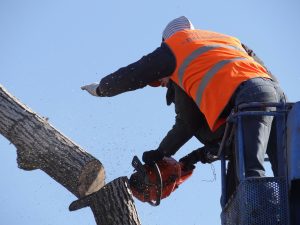Print a Sign-In Sheet | Spanish Version Coming Soon
Loggers, arborists, and other workers who engage in tree felling and harvesting are exposed to a variety of serious hazards including falling debris, moving machinery, and uneven terrain. In order to work safely, all employees must have awareness of their environment, actively communicate, and follow safe work practices.
Important Definition (Tree Length= Length of the tree being felled)
- Prior to any felling operation, an assessment of the tree(s) and the general area must be conducted to identify potential hazards such as danger trees, power lines, and terrain features.
- Trees must not be felled in a manner that may create additional hazards such as striking a rope, cable, power line, or machine.
- The immediate supervisor shall be consulted when unfamiliar or unusually hazardous conditions exist.
- While manual felling is in progress, no machinery shall be operated within two tree lengths of trees being felled. Exception: This provision does not apply to yarding machines performing tree pulling operations.
- Always stay at least 2 tree lengths away from any Mechanized or Manual tree felling
Operation
- Never approach any felling operation (Mechanized or Manual) unless the tree feller or equipment operator gives you consent to approach.
- All identified danger trees, including lodged trees and snags, shall be felled or removed using mechanical or other techniques that minimize employee exposure. If the danger tree is not felled or removed, it shall be marked, and no work shall be conducted within two tree lengths of the danger tree.
- Each danger tree shall be carefully checked for signs of loose bark, broken branches, or other damage before they are felled or removed. Accessible loose bark and other damage that may create a struck-by hazard should be removed or secured before removal.
- Felling on slopes should be done uphill from, or on the same level as, previously felled trees to avoid hazards posed by rolling or sliding of trees.
- Domino felling of trees is prohibited. This does not include the felling of a single danger tree by felling another single tree into it.
- Before manual felling is started, the feller should plan and clear a retreat path. The retreat path shall extend diagonally away from the expected felling line unless it’s determined that such a retreat path poses a greater hazard than an alternate path.
- Once the back cut has been made the feller shall immediately move a safe distance away from the tree on the retreat path.
- Prior to felling, conditions such as snow and ice accumulation, wind, lean of the tree, dead limbs, and location of adjacent trees shall be evaluated by the feller. Any unsafe conditions must be addressed before felling begins.
- When a spring pole or other tree under stress is cut, no employee other than the feller shall be closer than two trees lengths when the stress is released.
- An undercut shall be made in each tree being felled unless the employer demonstrates that felling the tree without an undercut will not create a hazard for an employee. The undercut shall be of a size so the tree will not split and will fall in the intended direction.
- A back-cut shall be made in each tree being felled. The back-cut shall leave enough hinge wood to hold the tree to the stump during most of its fall so that the hinge is able to guide the tree’s fall in the intended direction.
- The back-cut shall be above the level of the horizontal face-cut in order to provide an adequate platform to prevent kickback. Exception: The back-cut may be at or below the horizontal face-cut in tree pulling operations.
KEMI does not assume liability for the content of information contained herein. Safety and health remain your responsibility. This information is to be used for informational purposes only and not intended to be exhaustive or a substitute for proper training, supervision or manufacturers’ instructions/recommendations. KEMI, by publication of this information, does not assume liability for damage or injury arising from reliance upon it. Compliance with this information is not a guarantee or warranty that you will be in conformity with any laws or regulations nor does it ensure the absolute safety of any person, place or object, including, but not limited to, you, your occupation, employees, customers or place of business.

